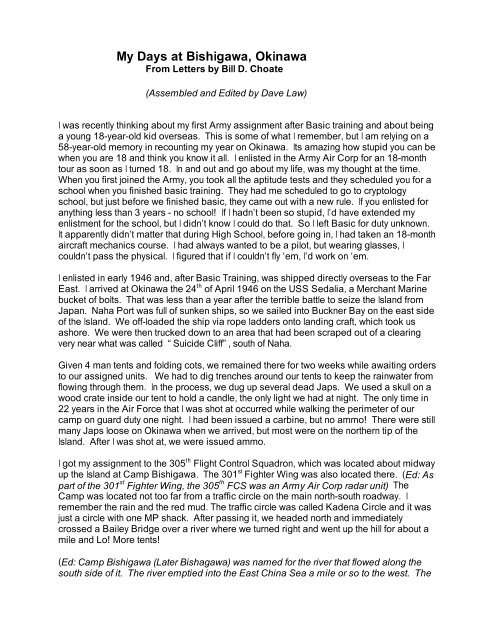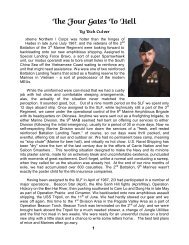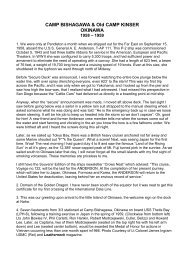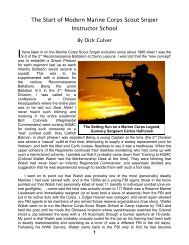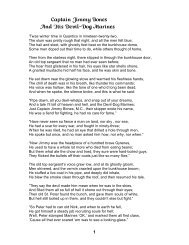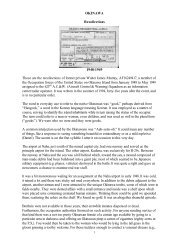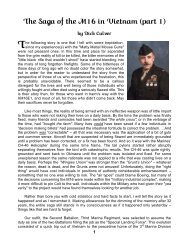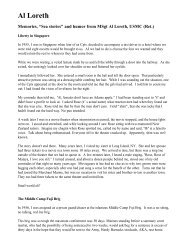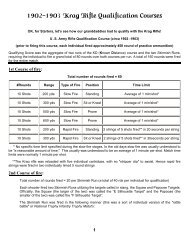Bill Choate at Bishagawa in 1946 - Rohrer, Bob Rohrer
Bill Choate at Bishagawa in 1946 - Rohrer, Bob Rohrer
Bill Choate at Bishagawa in 1946 - Rohrer, Bob Rohrer
You also want an ePaper? Increase the reach of your titles
YUMPU automatically turns print PDFs into web optimized ePapers that Google loves.
My Days <strong>at</strong> Bishigawa, Ok<strong>in</strong>awa<br />
From Letters by <strong>Bill</strong> D. <strong>Cho<strong>at</strong>e</strong><br />
(Assembled and Edited by Dave Law)<br />
I was recently th<strong>in</strong>k<strong>in</strong>g about my first Army assignment after Basic tra<strong>in</strong><strong>in</strong>g and about be<strong>in</strong>g<br />
a young 18-year-old kid overseas. This is some of wh<strong>at</strong> I remember, but I am rely<strong>in</strong>g on a<br />
58-year-old memory <strong>in</strong> recount<strong>in</strong>g my year on Ok<strong>in</strong>awa. Its amaz<strong>in</strong>g how stupid you can be<br />
when you are 18 and th<strong>in</strong>k you know it all. I enlisted <strong>in</strong> the Army Air Corp for an 18-month<br />
tour as soon as I turned 18. In and out and go about my life, was my thought <strong>at</strong> the time.<br />
When you first jo<strong>in</strong>ed the Army, you took all the aptitude tests and they scheduled you for a<br />
school when you f<strong>in</strong>ished basic tra<strong>in</strong><strong>in</strong>g. They had me scheduled to go to cryptology<br />
school, but just before we f<strong>in</strong>ished basic, they came out with a new rule. If you enlisted for<br />
anyth<strong>in</strong>g less than 3 years - no school! If I hadn’t been so stupid, I’d have extended my<br />
enlistment for the school, but I didn’t know I could do th<strong>at</strong>. So I left Basic for duty unknown.<br />
It apparently didn’t m<strong>at</strong>ter th<strong>at</strong> dur<strong>in</strong>g High School, before go<strong>in</strong>g <strong>in</strong>, I had taken an 18-month<br />
aircraft mechanics course. I had always wanted to be a pilot, but wear<strong>in</strong>g glasses, I<br />
couldn’t pass the physical. I figured th<strong>at</strong> if I couldn’t fly ‘em, I’d work on ‘em.<br />
I enlisted <strong>in</strong> early <strong>1946</strong> and, after Basic Tra<strong>in</strong><strong>in</strong>g, was shipped directly overseas to the Far<br />
East. I arrived <strong>at</strong> Ok<strong>in</strong>awa the 24 th of April <strong>1946</strong> on the USS Sedalia, a Merchant Mar<strong>in</strong>e<br />
bucket of bolts. Th<strong>at</strong> was less than a year after the terrible b<strong>at</strong>tle to seize the Island from<br />
Japan. Naha Port was full of sunken ships, so we sailed <strong>in</strong>to Buckner Bay on the east side<br />
of the Island. We off-loaded the ship via rope ladders onto land<strong>in</strong>g craft, which took us<br />
ashore. We were then trucked down to an area th<strong>at</strong> had been scraped out of a clear<strong>in</strong>g<br />
very near wh<strong>at</strong> was called “Suicide Cliff”, south of Naha.<br />
Given 4 man tents and fold<strong>in</strong>g cots, we rema<strong>in</strong>ed there for two weeks while await<strong>in</strong>g orders<br />
to our assigned units. We had to dig trenches around our tents to keep the ra<strong>in</strong>w<strong>at</strong>er from<br />
flow<strong>in</strong>g through them. In the process, we dug up several dead Japs. We used a skull on a<br />
wood cr<strong>at</strong>e <strong>in</strong>side our tent to hold a candle, the only light we had <strong>at</strong> night. The only time <strong>in</strong><br />
22 years <strong>in</strong> the Air Force th<strong>at</strong> I was shot <strong>at</strong> occurred while walk<strong>in</strong>g the perimeter of our<br />
camp on guard duty one night. I had been issued a carb<strong>in</strong>e, but no ammo! There were still<br />
many Japs loose on Ok<strong>in</strong>awa when we arrived, but most were on the northern tip of the<br />
Island. After I was shot <strong>at</strong>, we were issued ammo.<br />
I got my assignment to the 305 th Flight Control Squadron, which was loc<strong>at</strong>ed about midway<br />
up the Island <strong>at</strong> Camp Bishigawa. The 301 st Fighter W<strong>in</strong>g was also loc<strong>at</strong>ed there. (Ed: As<br />
part of the 301 st Fighter W<strong>in</strong>g, the 305 th FCS was an Army Air Corp radar unit) The<br />
Camp was loc<strong>at</strong>ed not too far from a traffic circle on the ma<strong>in</strong> north-south roadway. I<br />
remember the ra<strong>in</strong> and the red mud. The traffic circle was called Kadena Circle and it was<br />
just a circle with one MP shack. After pass<strong>in</strong>g it, we headed north and immedi<strong>at</strong>ely<br />
crossed a Bailey Bridge over a river where we turned right and went up the hill for about a<br />
mile and Lo! More tents!<br />
(Ed: Camp Bishigawa (L<strong>at</strong>er <strong>Bishagawa</strong>) was named for the river th<strong>at</strong> flowed along the<br />
south side of it. The river emptied <strong>in</strong>to the East Ch<strong>in</strong>a Sea a mile or so to the west. The
camp was loc<strong>at</strong>ed on a pla<strong>in</strong> loc<strong>at</strong>ed between the Bishigawa and another stream which<br />
jo<strong>in</strong>ed the Bishigawa near the Bailey Bridges.)<br />
Strange to f<strong>in</strong>d out the name of th<strong>at</strong> river after all these years. This river is where we got all<br />
our w<strong>at</strong>er. All the time I was there, we drank brown w<strong>at</strong>er, half-and-half with chlor<strong>in</strong>e. The<br />
only way we could stand to dr<strong>in</strong>k it was to hold our noses. It was easier when it was very<br />
cold, but there were no refriger<strong>at</strong>ors. I don’t th<strong>in</strong>k I ever saw anyth<strong>in</strong>g cold except the beer<br />
and coke <strong>in</strong> the Camp beer garden, when they f<strong>in</strong>ally got it opened.<br />
At Bishigawa, we lived <strong>in</strong> tents with wood floors until we got Quonset huts built about 2<br />
months l<strong>at</strong>er. My hut backed up on a cliff overlook<strong>in</strong>g the river. We were there a month<br />
before we got a shower, and then only because we built our own (cold w<strong>at</strong>er only!). Our<br />
electric supply for our huts was a small gener<strong>at</strong>or th<strong>at</strong> you could put <strong>in</strong> the back of a<br />
weapons carrier or jeep. It was always runn<strong>in</strong>g out of fuel.<br />
I found an old wash<strong>in</strong>g mach<strong>in</strong>e tub and rotor, so I made a wash<strong>in</strong>g mach<strong>in</strong>e out of it. I<br />
mounted it on one end of a sheet of plywood, put a jeep transmission and an electric motor<br />
on the other end and, us<strong>in</strong>g parts I made on the motor pool l<strong>at</strong>he, got it to work.<br />
We were all raw recruits and there were a bunch of 2 nd Lt.’s there who mostly flew P-47’s<br />
out of Yontan Airfield. When my group arrived, they l<strong>in</strong>ed us up and, go<strong>in</strong>g down the l<strong>in</strong>e,<br />
said; “You are a scope dope, you are a traffic controller, you are a radar mechanic, etc.”<br />
With no tra<strong>in</strong><strong>in</strong>g <strong>at</strong> all! I immedi<strong>at</strong>ely became an Air Traffic Controller! I rema<strong>in</strong>ed one for<br />
about a month, work<strong>in</strong>g up on Radar Hill (Ed: Yontan Mounta<strong>in</strong>). L<strong>at</strong>er, the C.O. called me<br />
<strong>in</strong> and asked if Id like to take over the ma<strong>in</strong>tenance of the Squadron’s L-5 <strong>at</strong> Yontan<br />
Airfield. The L-5 was a two place St<strong>in</strong>son with a 165hp eng<strong>in</strong>e th<strong>at</strong> the unit kept for all the<br />
2 nd Lt.’s to get their required 4 hours fly<strong>in</strong>g time each month. N<strong>at</strong>urally I jumped on it.<br />
Yontan Airfield was a few miles north west of the Camp. Our L-5, and another unit’s L-4<br />
th<strong>at</strong> was ma<strong>in</strong>ta<strong>in</strong>ed by a T/Sgt., were kept on the opposite side of the runway from the<br />
hangers. Except for the Control Tower, we were alone over there.<br />
Every morn<strong>in</strong>g Id check a jeep out of the Motor Pool, drive out to Yontan Airfield and do a<br />
daily check on the L-5 and any necessary work. If it was nice, or if I was expect<strong>in</strong>g some<br />
Lieutenant to be fly<strong>in</strong>g, I’d stick around and hope to get an <strong>in</strong>vit<strong>at</strong>ion to go fly<strong>in</strong>g. Fly<strong>in</strong>g<br />
around the Island, I’d see all these sunken ships very near the surface. My first thought was<br />
th<strong>at</strong> they were Jap ships sunk dur<strong>in</strong>g the tak<strong>in</strong>g of Ok<strong>in</strong>awa. Turned out to be our ships th<strong>at</strong><br />
were sunk by the Kamikaze fighters or dur<strong>in</strong>g the bad typhoon <strong>in</strong> Oct 1945. These pilots<br />
taught me how to fly, but would not let me takeoff or land. I’d fly the L-5 while they took<br />
pictures or just did some sight see<strong>in</strong>g.<br />
If it was ra<strong>in</strong><strong>in</strong>g they wouldn’t be fly<strong>in</strong>g the L-5, so after checks and ma<strong>in</strong>tenance, I had the<br />
rest of the day off. I’d take the jeep and go explor<strong>in</strong>g, usually stopp<strong>in</strong>g by the tent to pick up<br />
a friend. Well, the Adjutant (1 st Lt.) found out th<strong>at</strong> I had all this spare time and wanted to<br />
assign me to another job, <strong>in</strong> addition to the L-5. Major Fisher, the CO, vetoed th<strong>at</strong> idea and<br />
the Adjutant was forever pissed <strong>at</strong> me. He did everyth<strong>in</strong>g he could to make it miserable for<br />
me! I had worked on the L-5 for about 6 months when Lt. Stoop made a very hard land<strong>in</strong>g<br />
one day and busted a couple of str<strong>in</strong>gers. The plane was condemned and I was out of a
job!<br />
The Adjutant now had his chance! He put me on guard duty (6 on 24 off) on Radar Hill. My<br />
guard shack was about 100 yards down a r<strong>at</strong>her sharp <strong>in</strong>cl<strong>in</strong>e below the radar build<strong>in</strong>gs,<br />
which were also Quonset huts. The roads were all (crushed) coral. It was a “no m<strong>in</strong>d job”<br />
and I h<strong>at</strong>ed it, especially the midnight to 6 AM shift. It was hard to keep awake and there<br />
were b<strong>at</strong>s fly<strong>in</strong>g all over the place. I’d just sit there <strong>in</strong> the dark (no electricity) on the stool<br />
with my carb<strong>in</strong>e between my legs and stay awake. When I talked to the Adjutant about<br />
gett<strong>in</strong>g back <strong>in</strong>to radar, I found out wh<strong>at</strong> his bitch was with me. He said, “No”, I’d just get<br />
you tra<strong>in</strong>ed aga<strong>in</strong> and then you’d get transferred to another job. Sorry, you are stuck here<br />
as a guard until you leave!”<br />
Unless I recognized them, I had to stop everyone and check their ID. Now, no one wanted<br />
to come to a full stop because go<strong>in</strong>g up th<strong>at</strong> steep hill on the coral road made it hard to get<br />
started aga<strong>in</strong>. If I recognized them, I could just wave them through. I f<strong>in</strong>ally got to know<br />
everyone who came through, but the m<strong>in</strong>d is a funny th<strong>in</strong>g. For some reason I could never<br />
recognize the Adjutant, or even remember his name, until he came to a full stop. The<br />
Adjutant compla<strong>in</strong>ed several times about my not recogniz<strong>in</strong>g him. “You know who I am -<br />
just wave me through!” “Sorry Sir! I have to check your ID if I don’t recognize you and, for<br />
some reason, I can’t be sure it’s you until you come to a full stop.” With<strong>in</strong> two weeks I was<br />
pulled off guard duty and reassigned to the Motor Pool.<br />
It was sometime around the middle of July <strong>1946</strong> when the 305 th Fighter (sic) Control<br />
Squadron became the 623 rd Aircraft Control and Warn<strong>in</strong>g Squadron. (Ed: The 305 th Flight<br />
Control Squadron became the 623 rd Aircraft Control and Warn<strong>in</strong>g Squadron on July 2,<br />
<strong>1946</strong>.) Sorry, but I can’t tell you much about the 305 th . I don’t know why I even remember<br />
the design<strong>at</strong>ion. I was 18 years old and wonder<strong>in</strong>g wh<strong>at</strong> <strong>in</strong> the hell I was do<strong>in</strong>g <strong>in</strong> this mud<br />
hole. The historical aspects of the unit never entered my m<strong>in</strong>d.<br />
When we were assigned from the tents to the Quonset huts, our bunks were the regular GI<br />
fold<strong>in</strong>g cots with hang<strong>in</strong>g mosquito nets. After we’d been there about 6 months, and I’d<br />
learned how to scrounge, I loc<strong>at</strong>ed a couple of hospital beds (almost size) <strong>at</strong> the Naval<br />
Area. I brought them back and hid them near the huts.<br />
A buddy, Lloyd Leabo, was always compla<strong>in</strong><strong>in</strong>g about the cots. He was on duty <strong>at</strong> the<br />
time, so I pulled everyth<strong>in</strong>g off his bunk and cut away all the canvas. Then, criss-cross<strong>in</strong>g it<br />
with str<strong>in</strong>g, I put his bunk back together. He was <strong>in</strong> the habit of com<strong>in</strong>g <strong>in</strong> from work and<br />
plopp<strong>in</strong>g down hard on his bunk. He was 6’3” and weighed about 220 pounds. He came<br />
<strong>in</strong> and hit the sack and went all the way through. He was pissed! Lloyd jumped on my bunk<br />
and split it out completely. He was about to start on me until I took him out and showed him<br />
our new bunks. So, someone <strong>in</strong>herited a couple of good bunks after we left.<br />
Some other th<strong>in</strong>gs about Bishigawa. We had a baseball diamond graded out on a lower<br />
plane than our huts. Not too far from the Mess Hall, we had a Red Cross Club, called the<br />
Buzz-In Club. Two Red Cross women ran it. They were the only white women I saw while I<br />
was there. Beh<strong>in</strong>d the club were two trailers where we could develop and pr<strong>in</strong>t our own<br />
film. We got paid <strong>in</strong> Script Yen - 15 Yen to the Dollar. The only place we had to spend any<br />
money was a Quonset hut PX. Everyth<strong>in</strong>g was on one side and you went through <strong>in</strong> a l<strong>in</strong>e<br />
along the other side and po<strong>in</strong>ted out wh<strong>at</strong> you wanted. Open only from Noon to 1 PM, you
could get stale chocol<strong>at</strong>e bars, cigarettes (5 Yen a carton) and limited other choices. We<br />
had r<strong>at</strong>ion cards for cigarettes, limit one carton per week. I didn’t smoke <strong>at</strong> the time, so<br />
towards the end of the month Id buy a couple of cartons of cigarettes for 5 Yen each (33<br />
Cents) and sell them to the Ok<strong>in</strong>awans <strong>at</strong> a Dollar a carton. Then I’d buy some more, etc.<br />
and I’d have enough to get <strong>in</strong> a penny-ante poker game. I usually won enough to keep me<br />
go<strong>in</strong>g until payday.<br />
There was a swimm<strong>in</strong>g hole <strong>at</strong> the river where we used to go, but I can’t remember just<br />
were it was loc<strong>at</strong>ed. There were three guys th<strong>at</strong> got polio and one died. His name was<br />
Capta<strong>in</strong> Force. We quit us<strong>in</strong>g the swimm<strong>in</strong>g hole after th<strong>at</strong>. We had a beach on the<br />
Pacific side of the Island th<strong>at</strong> was called Ishikawa, if I am spell<strong>in</strong>g it right. I never saw the<br />
name <strong>in</strong> writ<strong>in</strong>g. (Ed: You are correct) It was the Enlisted beach. The Officer’s beach was<br />
further down and I don’t remember wh<strong>at</strong> it was called.<br />
We had a Buck Sergeant and some other NCO’s <strong>in</strong> the hut next m<strong>in</strong>e. On payday night<br />
they would go to the beer garden to buy several cases of beer and would then proceed to<br />
hang one on. St Hall had a Thompson submach<strong>in</strong>e gun hidden <strong>in</strong> the wall between the<br />
outside metal and the <strong>in</strong>side l<strong>in</strong>er of his Quonset. When he got drunk, he’d take the<br />
Thompson out to the cliff overlook<strong>in</strong>g the river and cut loose with a full magaz<strong>in</strong>e. Then he<br />
would run and hide the gun before the 1 st Sgt. showed up. We put up with th<strong>at</strong> for a couple<br />
of months. Then one night he got drunker than usual and l<strong>in</strong>ed us all up outside the<br />
Quonsets and began call<strong>in</strong>g us a bunch of “slanty eyed Japs”, say<strong>in</strong>g he was go<strong>in</strong>g to shoot<br />
us all. He was cry<strong>in</strong>g all the while. He was 4 or 5 years older then the rest of us and had<br />
been <strong>in</strong> comb<strong>at</strong> through several Island campaigns. We f<strong>in</strong>ally talked him out of shoot<strong>in</strong>g<br />
and the next day we found his Thompson, disassembled it, and threw it over the cliff <strong>in</strong>to the<br />
river. It is probably still there. Hall was shipped out shortly after th<strong>at</strong> episode. He was a<br />
nice guy when he was sober!<br />
An <strong>in</strong>terest<strong>in</strong>g event happened one Monday morn<strong>in</strong>g while I was still work<strong>in</strong>g on the<br />
St<strong>in</strong>son airplane. A staff car pulled up to the L-5 with a Capta<strong>in</strong> driv<strong>in</strong>g. There was a short<br />
stocky officer <strong>in</strong> the back se<strong>at</strong> who got out and asked me if I did all the work on the plane. I<br />
couldn’t see any <strong>in</strong>signia to tell me his rank. He had me do a “walk around” with him,<br />
check<strong>in</strong>g the prop and the lead<strong>in</strong>g edges of the w<strong>in</strong>g. He kept ask<strong>in</strong>g me if this dent and<br />
th<strong>at</strong> dent, etc. was there last week. I told him th<strong>at</strong> everyth<strong>in</strong>g appeared to be the same as<br />
when I started work<strong>in</strong>g on the plane 3 or 4 months before. The plane had a logbook and<br />
everyone was supposed to check the log to f<strong>in</strong>d out if it was ready to fly before us<strong>in</strong>g it.<br />
After fly<strong>in</strong>g, they had to enter their name, d<strong>at</strong>e, time and time <strong>in</strong> the air <strong>in</strong>to the log. I had<br />
grounded the plane over the weekend because it was due a complete <strong>in</strong>spection. He<br />
asked me who flew the plane S<strong>at</strong>urday afternoon. I told him th<strong>at</strong>, as far as I knew, no one<br />
had flown it, because I had grounded it and there was no entry. He thanked me and left. I<br />
don’t th<strong>in</strong>k I saluted him. When he was gone, the T/Sgt. th<strong>at</strong> ma<strong>in</strong>ta<strong>in</strong>ed the L-4 near me,<br />
came over and asked if I knew who th<strong>at</strong> officer was. When I told him, “No”, he said th<strong>at</strong> he<br />
was General Whitehead, Command<strong>in</strong>g General of the 8 th Air Force, head of all Army Air<br />
Corps on the Island!<br />
Talk<strong>in</strong>g l<strong>at</strong>er with some Lieutenants who came out to fly, I found out wh<strong>at</strong> had happened.<br />
Gen. Whitehead’s family had not yet arrived, but his family quarters were nearly competed.<br />
On S<strong>at</strong>urday afternoons, he would sit on his new back porch fly<strong>in</strong>g a box kite. It seems<br />
th<strong>at</strong> on Friday night, some of the officers <strong>at</strong> the Officer’s Club got to talk<strong>in</strong>g about the box
kite. On a bet, Lt. Stoop (the same Lt. Stoop th<strong>at</strong> would wreck my airplane and put me out<br />
of a job) said th<strong>at</strong> he would knock the kite out of the sky. There were four L-5 Sent<strong>in</strong>els on<br />
the Island. There were three <strong>at</strong> Kadena AB and there was m<strong>in</strong>e was <strong>at</strong> Yontan. Lt. Stoop<br />
did use my L-5 and, needless to say, did not make an entry <strong>in</strong> the logbook. As far as I<br />
know, Gen. Whitehead never found out who knocked his box kite out of the sky - but he was<br />
pissed!<br />
Anyway, the Motor Pool assignment wasn’t bad. I did not have an Air Corp career <strong>in</strong> m<strong>in</strong>d,<br />
so I didn’t m<strong>in</strong>d the Motor Pool for the rest of my tour. I ran the electrical department with an<br />
assistant to help me. I was more or less my own boss as long as I kept the vehicles<br />
runn<strong>in</strong>g. The workweek everywhere was 5 days a week until sometime <strong>in</strong> the fifties. You<br />
either stood <strong>in</strong>spection on S<strong>at</strong>urday morn<strong>in</strong>g or you worked your job. On S<strong>at</strong>urdays, come<br />
noon, Id make sure there was a usable jeep <strong>in</strong> my department th<strong>at</strong> would not run because<br />
of a miss<strong>in</strong>g rotor <strong>in</strong> the distributor. After lunch I’d stop by the Motor Pool, replace the rotor<br />
and drive by our hut to pick up a couple of buddies. We’d spend the rest of the day boon<br />
dock<strong>in</strong>g, explor<strong>in</strong>g caves or any other place we found <strong>in</strong>terest<strong>in</strong>g. Never did get caught <strong>at</strong><br />
it.<br />
I would always take the test drives up toward radar hill. There was a narrow road about a<br />
mile up th<strong>at</strong> turned off to the left, went through an old Jap emplacement, and came back to<br />
the Camp near the Motor Pool. One day I wrecked a jeep up there on a test drive. I just<br />
rolled it over. I walked back to the Motor Pool, th<strong>in</strong>k<strong>in</strong>g I would just leave it there, because<br />
there was talk about mak<strong>in</strong>g you pay for a jeep if you wrecked it. The only damage it did to<br />
the jeep was to break off the w<strong>in</strong>dshield. It was the only jeep <strong>in</strong> the Motor Pool th<strong>at</strong> had a<br />
good w<strong>in</strong>dshield. I changed my m<strong>in</strong>d and got the guy th<strong>at</strong> drove the wrecker to go with me<br />
and we went back to the site. The jeep was upside down. We turned it onto its wheels,<br />
started it up and it smoked like hell. The smoke cleared up, so I drove back to the Motor<br />
pool, and cleaned all the oil off the hood and the eng<strong>in</strong>e. I never said a word except to a<br />
couple of buddies - everyth<strong>in</strong>g back to normal.<br />
One day, Leabo and I were on the beach and there was a derelict LST about 150 (yd/ft?)<br />
off the beach and we decided th<strong>at</strong> we’d swim out to it. I don’t know if it was left over from<br />
the ‘45 land<strong>in</strong>gs or washed up by the bad typhoon <strong>in</strong> Oct ‘45. Anyway, we stripped down<br />
completely bare, as there was no one <strong>in</strong> sight, and started out. The w<strong>at</strong>er was so shallow<br />
th<strong>at</strong> by the time we got to the ship, we were only knee deep <strong>in</strong> the w<strong>at</strong>er. We climbed<br />
aboard and started look<strong>in</strong>g though the ship. Noth<strong>in</strong>g there. When we got ready to leave,<br />
we looked back <strong>at</strong> the beach and there must have been 30 men, women and children<br />
where we’d left our cloth<strong>in</strong>g. We were bare-ass naked so we waited. After about 30<br />
m<strong>in</strong>utes, they still hadn’t left so we did the only th<strong>in</strong>g th<strong>at</strong> we could. We waded back as if<br />
they didn’t exist, put on our clothes and walked away. Not a word from anyone.<br />
Once we found a stack of P-38 drop tanks, so we took one, split it <strong>in</strong> half down the center,<br />
and widened it. We found a little horizontal 4 cyl<strong>in</strong>der eng<strong>in</strong>e (like a VW, except smaller),<br />
found a prop somewhere and we made us a bo<strong>at</strong>. When the tide was <strong>in</strong> the river was<br />
pretty wide below the Bailey Bridge. We’d take a box of hand grenades, go to the middle<br />
of the river and pull the p<strong>in</strong> and toss the grenade <strong>in</strong>to the river. Then we would scoop up<br />
the fish. All k<strong>in</strong>ds of fish. Some blowfish, one very strange, about 15 <strong>in</strong>ches long and had<br />
upper and lower teeth just like a human. (Ed: Possibly a Parrot or Triggerfish) When we<br />
had enough, we’d take the edible fish back to the Squadron area and have a fish fry for
ourselves and anyone else th<strong>at</strong> wanted to particip<strong>at</strong>e.<br />
A couple of other guys built a bo<strong>at</strong> and went to sea. The tide came <strong>in</strong> (?) while they were<br />
out (maybe a mile out) and they got stranded on a reef. Had to be rescued by Air/Sea<br />
Rescue.<br />
I only got to Ie Shima one time. Air Sea Rescue ran a bunch of us over one Sunday. The<br />
only time I came near gett<strong>in</strong>g seasick. We visited Ernie Pyle’s monument, looked <strong>at</strong><br />
Chocol<strong>at</strong>e Drop Hill and went back to Naha. I don’t remember even see<strong>in</strong>g any other<br />
people on the island.<br />
We always had a shortage of parts, especially b<strong>at</strong>teries. I had everyone on the look out for<br />
wrecked jeeps. When I heard there was one on the side of a road, I’d take off with the<br />
toolbox and strip the wreck of all usable parts. I worked <strong>in</strong> the Motor Pool until the end of<br />
my assignment on Ok<strong>in</strong>awa.<br />
Some of my friends and names th<strong>at</strong> I remember were Thomas B. Harn from Tampa<br />
Florida. Tom has passed away. Harvey L. Haugrud from Barnesville, M<strong>in</strong>n. He’s still<br />
there. Lloyd P. Leabo from Phoenix. Lloyd died of cancer caused by asbestos <strong>in</strong> 2002.<br />
Dean C. Wilson from Independence, KS. He never left the area, is retired and liv<strong>in</strong>g on a<br />
farm about 30 miles from Independence. I remember a guy named Workman from Oregon.<br />
Probably the other names are deep <strong>in</strong> my memory but need some jogg<strong>in</strong>g to br<strong>in</strong>g to the<br />
surface. Major Fisher, our CO, and Lt. Stoop, come to m<strong>in</strong>d right now.<br />
I mentioned Yontan, where I worked on the L-5. This was a Japanese Zero fighter base<br />
and we had P-47’s there. There was a row of P-47’s l<strong>in</strong>ed up near the hangers, all their<br />
props curled back. The runway was fairly short. At the end of the runway was the coral<br />
road you used go<strong>in</strong>g to the hangers. Then there was a deep pit where they had dug out the<br />
coral for the roads. At the far side of the pit, there was a big coral rock stick<strong>in</strong>g up. If a<br />
pilot touched down too far down the runway to get stopped and went off the end of the<br />
runway and cleared the road, he had the pit <strong>in</strong> front of him and if he could avoid it, the rock<br />
on the far side. One of the pilots didn’t avoid it. We had two or three of our pilots all killed<br />
<strong>in</strong> day. I’m a little fuzzy on th<strong>at</strong>. One of the pilots killed <strong>in</strong> a P-47 accident was my Motor<br />
Pool Officer. The Capta<strong>in</strong> th<strong>at</strong> replaced him as my Motor Pool Officer was a pretty nice<br />
guy.<br />
I was assigned to the Motor Pool about the last 3 months th<strong>at</strong> I was <strong>at</strong> Bishigawa. I had<br />
several Jap prisoners work<strong>in</strong>g for me. The most amaz<strong>in</strong>g th<strong>in</strong>g was, not one of them were<br />
comb<strong>at</strong> soldiers th<strong>at</strong> had fought the Americans! They, like all the other prisoners, were<br />
either “cooks” or “truck drivers”. Years l<strong>at</strong>er, I heard the same story from other ex-military<br />
Japanese <strong>at</strong> Yokota AB. The Jap troops must have been well fed and had plenty of trucks<br />
to get around <strong>in</strong>! After I retired, I got to know a Jap Zero pilot, - but th<strong>at</strong> is another story. I<br />
had just one Ok<strong>in</strong>awan work<strong>in</strong>g for me <strong>in</strong> the Motor Pool. I separ<strong>at</strong>e the Ok<strong>in</strong>awans from<br />
the Japanese. I know th<strong>at</strong> the Japs looked down on the Ok<strong>in</strong>awans as second class<br />
citizens, the same as a civil war white from Georgia did a black man. The Japs took<br />
anyone they could f<strong>in</strong>d <strong>in</strong>to their Army as laborers. I asked on old Ok<strong>in</strong>awan man wh<strong>at</strong> he<br />
was do<strong>in</strong>g dur<strong>in</strong>g the <strong>in</strong>vasion, how did he avoid all the shell<strong>in</strong>g? He said he spent his time<br />
<strong>in</strong> one of the tombs, read<strong>in</strong>g “Gone with the W<strong>in</strong>d”. I don’t know if he was serious or not, but<br />
he spoke very good English.
My tour ended <strong>in</strong> March 1947. I was shipped back on another Merchant Mar<strong>in</strong>e ship th<strong>at</strong><br />
looked worse than the one I had arrived <strong>in</strong>. I stayed out 20 months and then re-enlisted.<br />
(Ed: By then the Army Air Corp was the United St<strong>at</strong>es Air Force.)<br />
Early <strong>in</strong> 1949, I was st<strong>at</strong>ioned <strong>at</strong> McChord AFB, Wash<strong>in</strong>gton. One day, when I was <strong>in</strong> the<br />
PX, I ran <strong>in</strong>to th<strong>at</strong> Capta<strong>in</strong> th<strong>at</strong> had been my last Motor Pool Officer <strong>at</strong> Bishigawa. The first<br />
th<strong>in</strong>g he said to me was, “Have you wrecked any more jeeps l<strong>at</strong>ely?”<br />
Note: <strong>Bill</strong> rema<strong>in</strong>ed <strong>in</strong> the Air Force until retirement <strong>in</strong> 1969. He is a semi-retired<br />
gunsmith liv<strong>in</strong>g <strong>in</strong> Overgaard, Arizona (up on the Mogollon Rim). He returned to<br />
Ok<strong>in</strong>awa <strong>in</strong> 1966 with the “hush hush”YF-21 program. And th<strong>at</strong> too is another story!<br />
While there, he lived <strong>in</strong> an area called “Morgan Manor”, which is near Kadena Circle,<br />
across the highway from his old Camp Bishigawa. <strong>Bill</strong> visited the then abandoned and<br />
vacant site of the Camp and found only remnants of found<strong>at</strong>ions. By 2002 there were<br />
other structures <strong>in</strong> place <strong>at</strong> the loc<strong>at</strong>ion of the Camp, which rema<strong>in</strong>s part of the jo<strong>in</strong>tservices<br />
USAF Kadena Ammunition Storage Facility.


